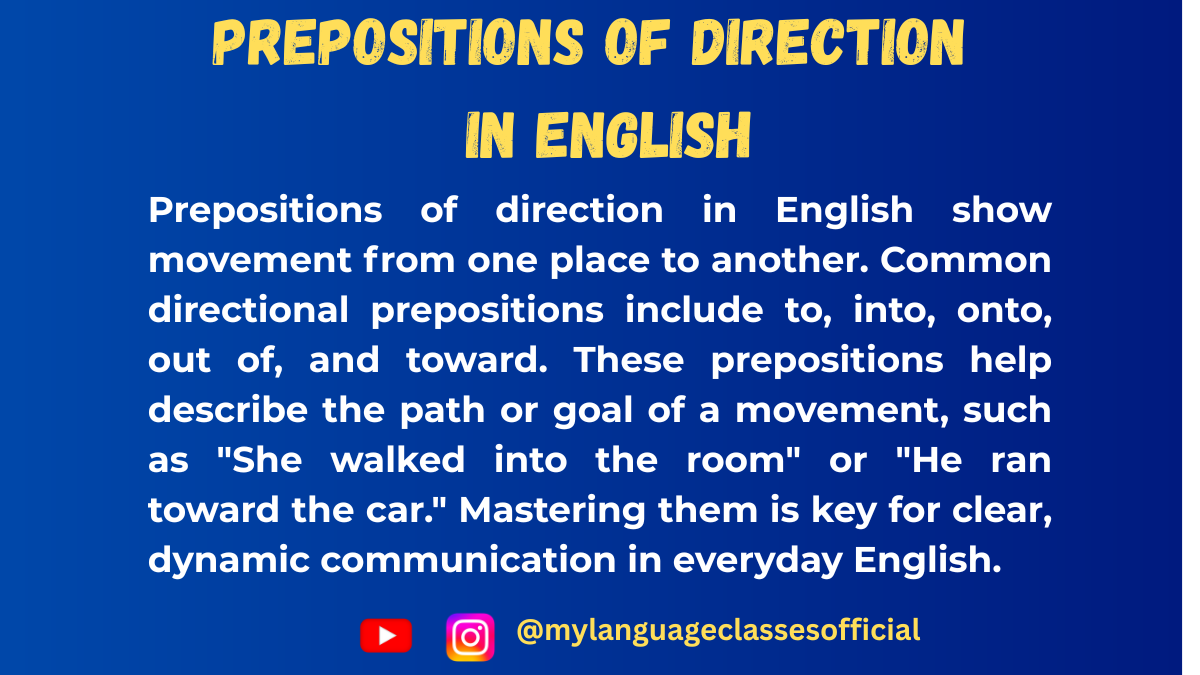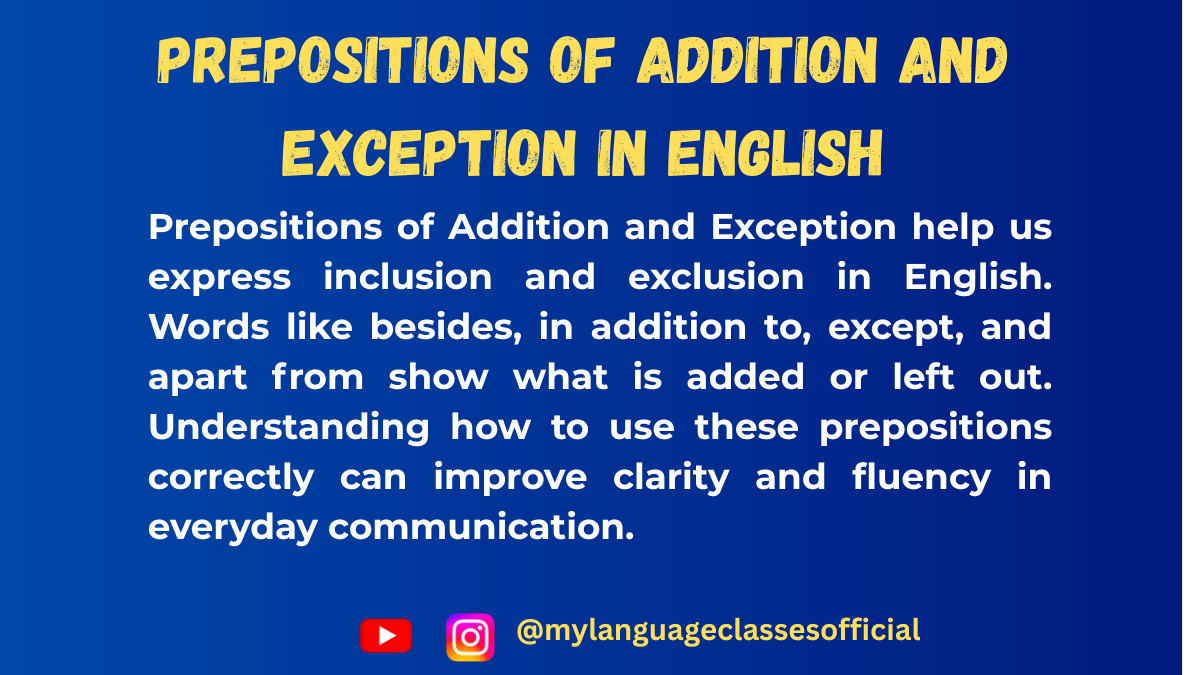Your cart is currently empty!
Tag: prepositions for beginners
-

Prepositions of Direction in English
Prepositions of direction indicate movement from one place to another. They are essential in describing how something moves or changes position concerning another object.
List of Prepositions of Direction and Their Usage
Preposition Meaning Example Sentence 1 Example Sentence 2 To Movement towards a destination She went to the park. He sent a letter to his friend. Into Movement from outside to inside She walked into the room. The cat jumped into the box. Onto Movement towards a surface The child climbed onto the table. He jumped onto the bed. Out of Movement from inside to outside She ran out of the house. He took his phone out of his pocket. Towards Movement in the direction of something She moved towards the door. He walked towards me with a smile. Away from Movement in the opposite direction She walked away from the fire. The dog ran away from the stranger. Up Movement from a lower position to a higher one He climbed up the hill. The plane soared up into the sky. Down Movement from a higher position to a lower one The ball rolled down the hill. She walked down the stairs. Across Movement from one side to another He swam across the river. The children ran across the street. Over Movement above something The bird flew over the lake. He jumped over the fence. Under Movement beneath something The dog crawled under the table. The ball rolled under the chair. Along Movement following a path He walked along the beach. The car drove along the highway. Past Movement beyond a certain point They walked past the school. He drove past the mall. Through Movement within a space from one end to another She ran through the tunnel. The wind blew through the trees. Around Movement in a circular direction He walked around the park. The car drove around the roundabout.
More Example Sentences
- The boy ran to his mother as soon as he saw her.
- She poured the coffee into the cup carefully.
- He jumped onto the boat from the dock.
- The cat ran out of the house when the door was open.
- The athlete sprinted towards the finish line.
- They moved away from the dangerous area.
- The monkey climbed up the tree quickly.
- She walked down the street, enjoying the fresh air.
- He drove across the city to meet his friend.
- The plane flew over the mountains.
Fill in the Blanks
- She jumped ___ the swimming pool.
- He walked ___ the tunnel to reach the other side.
- The dog ran ___ the street to chase the cat.
- The helicopter flew ___ the buildings.
- He climbed ___ the ladder to fix the roof.
- The train passed ___ the bridge.
- The girl moved ___ the stage to receive her award.
- The kids walked ___ the road to reach school.
- The car drove ___ the highway without stopping.
- He ran ___ the hill with great speed.
Answers:
- into
- through
- across
- over
- up
- over
- towards
- across
- along
- down
Things to Keep in Mind
- Prepositions of direction always describe movement from one place to another.
- Some prepositions like to and towards may seem similar but have different uses (e.g., “to” specifies the destination, while “towards” indicates movement in a direction without necessarily reaching the destination).
- Prepositions such as into and onto describe entering or moving onto a surface, while in and on describe static positions.
- Over and under describe movement above and below something, respectively.
- Across and through both describe movement, but “across” is typically for flat surfaces, while “through” indicates movement within an enclosed space.
Conclusion
Prepositions of direction are essential for clear communication when describing movement and changes in position. Understanding their proper usage will enhance both written and spoken English. By practicing these prepositions in different contexts, you can develop a natural sense of their application and improve your fluency. Keep practicing with more sentences and exercises to master this important grammar topic!
If you enjoyed this lesson, be sure to check out more posts like this on my blog at My Language Classes. Don’t forget to subscribe my YouTube channel and follow me on Instagram for the latest language learning tips and lessons. Leave a comment below to share your thoughts, or ask any questions you have about nouns.
Happy learning! 😊
-

Prepositions of Place in English
Prepositions of place are essential in English as they help indicate the location of people, objects, or actions. Understanding them correctly enhances fluency and accuracy in spoken and written English. This article will provide a detailed explanation, a categorized list, examples, exercises, and essential things to remember while using prepositions of place.
What is a Preposition of Place?
A preposition of place is a word used to show the location or position of an object concerning another object. These prepositions answer the question “Where?” and are essential for clear communication.
List of Prepositions of Place and Their Usage
Below is a list of commonly used prepositions of place along with their meanings and example sentences.
Preposition Usage Example 1 Example 2 In Inside a space, area, or container The books are in the bag. She is in the room. On On the surface of something The book is on the table. There is a painting on the wall. At A specific point or location She is at the bus stop. We met at the restaurant. Under Below something The cat is under the table. He hid under the bed. Over Above something without touching The lamp is over the table. The bridge is over the river. Above Higher than something The clock is above the door. Planes fly above the clouds. Below Lower than something His shoes are below the bed. The valley is below the mountain. Between In the middle of two things The park is between the school and the mall. She sat between her friends. Next to Beside something The school is next to the hospital. She is sitting next to her brother. Behind At the back of something The car is behind the building. There is a garden behind the house. In front of Before something The teacher is in front of the class. There is a park in front of my house. Inside Within an enclosed space The keys are inside the drawer. She stayed inside the house. Outside Opposite of inside The kids are playing outside the house. There is a cat outside the shop. Near Close to something There is a bank near my house. She lives near the station. Far from Distant from something His school is far from his home. The hotel is far from the airport.
More Example Sentences:
- There is a mirror on the wall.
- The plane is flying above the clouds.
- She is waiting at the entrance.
- The ball is under the chair.
- The bakery is next to the supermarket.
- He kept his phone inside his pocket.
- The children are playing outside the house.
- The library is between the coffee shop and the bank.
- The painting is hanging over the sofa.
- There is a tree behind the house.
Fill in the Blanks:
- The cat is ___ the table.
- The park is ___ the school and the library.
- She is waiting ___ the bus stop.
- The ball rolled ___ the couch.
- The students are sitting ___ the teacher.
- The books are ___ the bag.
- The hotel is ___ the beach.
- The keys are ___ the drawer.
- He is standing ___ the door.
- The stars are shining ___ the sky.
Answers:
- under
- between
- at
- under
- in front of
- in
- near
- inside
- behind
- above
Things to Keep in Mind:
- Articles: Use definite and indefinite articles appropriately (e.g., “in a house” vs. “in the house”).
- Gender & Number: Prepositions of place do not change based on gender but may be influenced by singular/plural usage (e.g., “between two buildings”).
- Fixed Expressions: Some prepositions are part of set phrases, such as “at home,” “on the street,” or “in bed.”
- Context Matters: Some prepositions can change meaning based on the context (e.g., “on the bus” vs. “in the car”).
- Prepositions vs. Adverbs: Some words can function as both prepositions and adverbs. For example, “inside” can be a preposition in “inside the house” but an adverb in “Come inside!”
Conclusion
Prepositions of place are fundamental in English grammar and crucial for describing locations accurately. By understanding their usage and practicing them through exercises, you can significantly improve your English fluency. Keep practicing with real-life situations, and soon, using prepositions of place will become second nature!
If you enjoyed this lesson, be sure to check out more posts like this on my blog at My Language Classes. Don’t forget to subscribe my YouTube channel and follow me on Instagram for the latest language learning tips and lessons. Leave a comment below to share your thoughts, or ask any questions you have about nouns.
Happy learning! 😊


